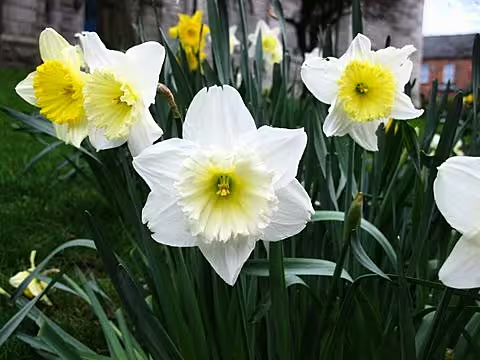
Probably the most popular and easily recognisable flower, the ubiquitous and delightful daffodil in its many colourful varieties is undoubtedly the people’s favourite and the classic symbol for spring. Immortalised in William Wordsworth's wonderful and famous poem, daffodils are relatively trouble free easy to grow plants which produce reliable delightful colourful displays repeatedly each and every year.
Here are some tips to guarantee your very own successful daffodil delights:

- Daffodils are best planted in late summer/early autumn. Plant depths will vary depending on variety, but typically 100mm deep (or 2-3 times the size of the bulb). No special ground preparations is necessary, but before planting bulbs in very damp soil, add some grit and compost at base of planting hole.
- Daffodils may be planted literally anywhere, in borders, lawns and containers. They also make excellent cut flowers for indoor displays. They produce wonderful natural looking displays when planted in random drifts and will naturalise and increase in numbers with time. Although capable of growing in a wide range of soil and site conditions, they prefer sunny positions. Similar to other perennial flowers, daffodil bulbs will expand to form clusters which will eventually become very congested. Simply divide the clusters and replant every 5 years or more.
- If planting in sandy soils, bulbs must be planted deeper otherwise avoid shallow planting there is the risk of the flowers toppling over and/or drying out.
- Daffodils are also ideal for growing in containers but it is very important to water regularly during the growing season and during the dormant season that the soil is not allowed to become completely dry.
- Daffodils are excellent for transforming difficult areas quickly and easily such as embankments or hard to manage areas under trees. Simply scatter the bulbs and plant in random groups to create large drifts and a wonderful carpet of colour.

Apart from planting healthy bulbs (soft and or discoloured bulbs should be discarded), there are few problems to watch out for. Occasionally daffodils may suffer ‘blindness’ i.e. fail to flower. Poor cultivation or poor growing conditions are common causes for ‘daffodil blindness’. For bulbs growing in grass areas, cutting the foliage too soon after flowering is the most likely cause of ‘blindness’. Once flowering has finished, faded blooms should be cut and removed. However it is very important that the foliage remains for at least six weeks and only cut after it has faded, this will allow the bulbs build up adequate food reserves for the following year.







